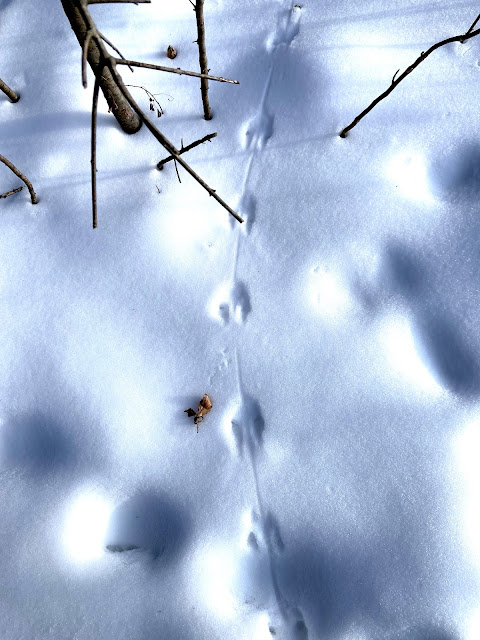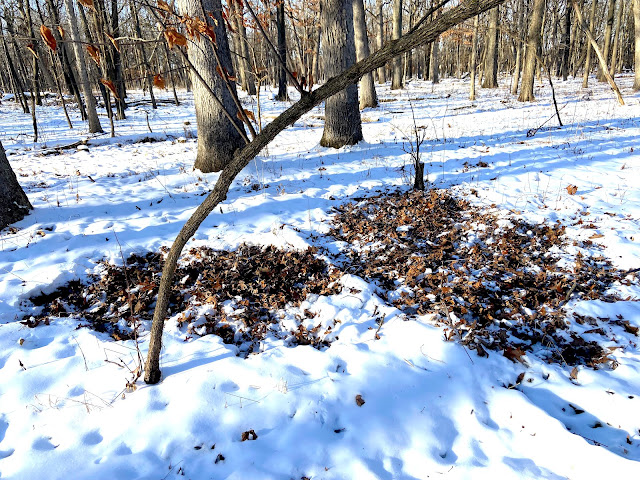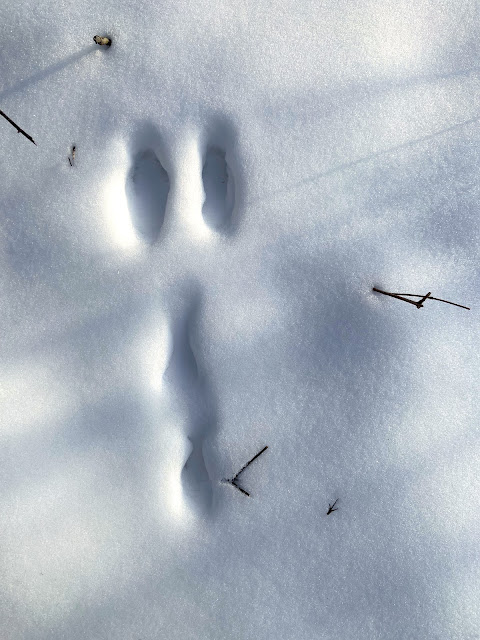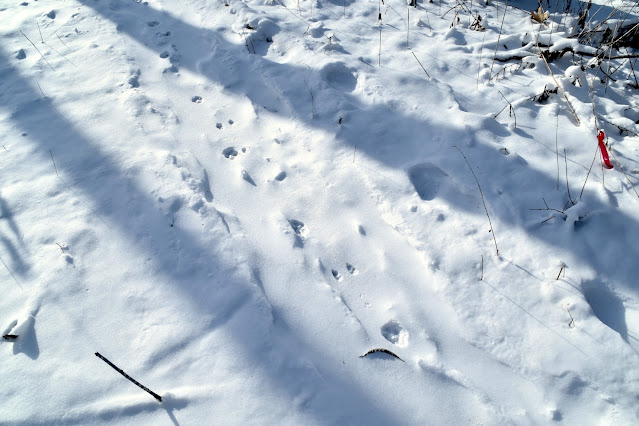The original post was from January 21, 2024. In response, Rebeccah Hartz sent photos and comments, which follow.
On Jan. 21, Stephen Packard wrote: "During my two-hour walk in Somme Woods, I saw no birds and only one species of mammal. Yet I felt community with my wild neighbors, as their tracks were everywhere."
Here, amid deer hoof prints, juncos left prints from their wing feathers. A careful look at the brown spots here and there in the snow revealed their purpose here - eating the seeds that were falling into the snow from the tree above.
This photo shows the seeds better. Hop hornbeam seeds are enclosed in brown papery containers (that look as they hang in clusters on the tree like the hops used to brew beer).
These tracks were made by a white-footed mouse - probably the commonest animal in the woods. As they bound along, all four feet land close together, and their long tail makes a signature imprint in the snow.
This is a "mouse highway." Mice spend most of their time relatively safe from predators under the snow. But here, a mouse has emerged repeatedly from its snow tunnel, through the dark hole at the bottom of the photo, to cross the Outer Loop footpath (here showing coyote footprints), probably to get to one of its food caches. Mice hide seeds and nuts in little storehouses and then venture out from time to time to retrieve and bring them to their cozy nest to eat. That coyote would be happy to catch that mouse for its own meal.
Here, under some old bur oaks, much of the snow has been kicked aside, as deer look for acorns. Most trees produce a big crop of acorns only every few years. But the deer know where those places are. Acorns are a major winter food for them.
Here, in a large area of unbroken snow, two patches stand out. Probably some squirrel has cached two patches of acorns under white oaks. Squirrels bury some acorns, but that's a lot of work. So sometimes they just assemble them in the leaves, and if the deer find them, they'll raid them.
White oaks are identifiable in winter by their whitish bark. The oldest trees in Somme Woods are bur and white oaks. Typical old ones have wide spreading limbs and the remains of now-dead spreading limbs that died in the shade before we rescued them from invasive "pole trees." The tall, dense, skinny pole trees are the most common trees in this photo. Many natural, now-rare woodland plants and animals don't survive the dense shade produced by the pole trees. Here in the foreground, stewardship volunteers have removed enough of them to support the development of new growth and new life.
The woodland footprints here are those of stewards who, on a below-zero day yesterday, cut invasive trees to make room from some young oaks (upper left). They left the stumps to cut low later when they'll have a better chance to apply herbicide to the stumps without having to contend with the snow.
A second bonfire pile from yesterday. Though without flames, the coals can remain hot. Notice that in the background of this former open oak woodland - tall, skinny, invader trees are way too dense. As the stewards continue to thin them, we'll start to see the first bur and white oak reproduction in decades as well as increasing populations of the now-rare animals, plants, and other biota that depend on sunny oak woodlands.
These deer were sleeping next to Fourth Pond, where the Forest Preserve staff girdled large cottonwood trees to reduce shade years ago. It's easy to see where the strip of bark and phloem were removed from two trees on the right. As I walked by on the Outer Loop trail, the deer stood up, just in case. After I passed by, they lay back down and went back to sleep.

Here a "mouse highway" is crossed by a set of coyote tracks. If you zoom in, you can probably recognize the coyote tracks which, like dog tracks, show their five foot pads (unlike deer tracks, that show two hoof marks).
Deer and mouse tracks.
Rabbit tracks
After two hours in Somme Woods, I headed west to cross Waukegan Road into Somme Prairie Grove. While in Somme Woods I didn't see a single bird, though that could have been because I mostly had my head down, looking down for tracks. I did hear just two birds calling: one chickadee and one hairy woodpecker.
The first Somme Prairie Grove photo shows these tunnels. There are no indications of hopping here, or long tail marks. These trails are thus likely made by meadow voles (probably the most common animals of our grasslands) or shrews.
I'd vote for shrews, as the voles have long-established tunnels at ground level, under the grass. Voles are vegetarians and in winter mostly eat seeds. Shrews are predators and mostly eat insects in winter. They bulldoze around looking for cocoons, chrysalids, and hibernating invertebrates of any sort. They will also sometimes kill and eat white-footed mice. It's odd to think of tiny shrews hunting for the same animal as big coyotes. But most every predator eats mice, also including foxes, snakes, weasels, hawks, and owls.
Another sign of the white-footed mouse is isolated holes like the one above. Sometimes I see mouse tracks leading away from them. But mostly they look like this. Was the mouse claustrophobic and just wanting to take a look around? Or had the tunnel air gotten musty, and the hole was for better breathing? Perhaps some expert knows. I just get a kick out of seeing them.
Here some birds - probably tundra sparrows (more commonly, if misleadingly, known as American tree sparrows) have been eating seeds knocked off nearby plants. I saw none, indeed no birds at all, as in Somme Woods, but the frequent tracks indicated that they were here, somewhere. They tend to be in flocks of twenty to fifty, close together, and if you don't happen to walk through the part of the savanna where they are at that moment, you don't see them.
These four deer were part of a herd of ten in a bur oak grove. Deer were the only animals I actually saw in Somme Prairie Grove, so you might think I would have been glad to see them. Well, I was a little glad. But I was mostly disappointed. A preserve the size of Somme Prairie Grove can sustainably support about two deer, according to the best research. Forest Preserve staff and Village of Northbrook staff both cull some deer in and near this preserve, but they don't cull nearly enough.
The last photo for this post is below:
Speak of the devil, here a buck has used his antlers to nearly girdle a handsome young bur oak. The bucks choose trees that bend a bit, in order to practice the jousting that results in dominance and best mating prospects. We cage as many young oaks as we find time for, especially in more open areas where farmers long ago cut trees to make way for crops or pasture. But we didn't get to this one. A winter walk is a good time to asses what kinds of work we'll need to do more of next summer and fall.
To anyone who's enjoyed learning from it, thanks for accompanying me on this walk. It was a pleasure to have you along, as I looked for what might be interesting.
End of original post.
On January 15, one of those dangerously cold, sub-zero days, Rebeccah Hartz also took a walk in those same Somme Woods, snapped the following photos, and recorded these thoughts:
"The woods were full of life this afternoon, in the awesome silence of the cold. For what it's worth, I think with the right clothes the temperature did not feel so extreme, and the signs of so much life were continuously exciting. I hope these photos capture at least some hints of that excitement."
 |
| This was one of the longest tunnels I came across. You can see the little ridge of slightly protruding/cracked surface snow where the creature burrowed along, and the occasional break where the creatures surfaced and took up running. I suspect shrews. |

There were tunnels everywhere! Tracks of a white-footed mouse led to this one.
Detail of the photo shown above. I think the entrances and air vents are irresistible. I like how you can tell there's warmer air coming up from beneath the snow by the longer ice crystals around the hole.
I walked the Middle Loop trail. No person had been out on it yet, just a solitary coyote and rabbit. Fortunately for the rabbit, the two sets of tracks head in opposite directions.
At the edge of Fourth Pond, two tundra sparrows were feasting on seeds. They accompanied me the whole time I was there. Here they are against the backdrop of one of the fallen cottonwoods. Above us, a red-headed woodpecker hopped and glided from tree to tree.
Coyote tracks headed out on the snow-covered pond. This picture doesn't show it, but in places you can see spots where the coyote lost its balance and went skittering across the ice.
Then, thrillingly enough, this beauty appeared.
She or he gave me a brief look and made a quick retreat into the oaks.
Acknowledgements
Thanks to Rebecca Hartz for great photos and thoughts. Thanks to Eriko Kojima for proofing and edits.


























